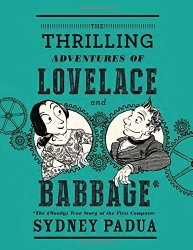
 The Thrilling Adventures of Lovelace and Babbage*
The Thrilling Adventures of Lovelace and Babbage**The (Mostly) True Story of the First Computer
Reviewed June 16, 2015.
Pantheon Books, New York, 2015. 319 pages.
Starred Review
2015 Sonderbooks Stand-out: #5 Fiction
I don’t think I’ve ever seen a book quite like this. It’s based on a web comic. The comic is based on two actual historical geniuses, Charles Babbage and Ada Lovelace. But Sidney Padua invents the existence of pocket universes, where Charles Babbage actually builds his Analytical Engine (In real life, he never built it, always coming up with a better idea before bringing an earlier idea to completion.), and Ada Lovelace actually lived long enough to help him program it.
This book describes their adventures in the pocket universes. Now, in our universe, computers actually got built in the age of electricity, using vacuum tubes and electric current. Babbage designed his Difference Engine and Analytical Engine to run on steam, so that’s what’s drawn here – a grand Difference Engine with cogs and gears and powered by steam.
Other historical figures of the period run through these pages, and some of the most fun to be found here are in the extensive footnotes, endnotes, and appendices. While reading about what never happened, you’ll learn all sorts of facts about what did actually happen. You’ll come to know Lovelace and Babbage, seeing them in action, using words they actually wrote in their real-life lifetimes.
Here’s how Sidney Padua describes beginning to write this comic:
It was in a pub somewhere in London in the spring of 2009 that I undertook to draw a very short comic for the web, to illustrate the very brief life of Ada Lovelace. This was suggested to me by my friend Suw, also in the pub, who was (and still is) the impresario of an annual women-in-technology virtual festival she had named after Lovelace, a historical figure of whom I think I was hazily aware.
As anybody else would do, I looked up “Ada Lovelace” on Wikipedia. There I found the strange tale of how, in the 1830s, an eccentric genius called Charles Babbage only just failed to invent the computer, and how the daughter of Lord Byron wrote imaginary programs for his imaginary computer. It was such an extraordinary story, so full of weird personalities and poetic flourishes that it hardly seemed true; but at the end of it the facts thudded back to dull reality. Lovelace died young. Babbage died a miserable old man. There never was a gigantic steam-powered computer. This seemed an awfully grim ending for my little comic. And so I threw in a couple of drawings at the end, imagining for them another, better, more thrilling comic-book universe to live on in.
She goes on to say, “Almost everybody had failed to realize that my alternate-universe ending was a joke.” And so she began writing these comics.
The result is quirky, full of facts, and a whole lot of fun. I also love the Victorian, over-the-top style used, especially for title pages and diagrams.
And, yes, I will be watching the webpage for more adventures.
And, okay, I'll admit it. I brought this book to a Book Dating event. It's like Speed Dating -- only everyone brings a book, and you have something to talk about. I thought this book was a nice blend of fiction and nonfiction -- and that anyone who thinks it's cool will be someone I will be able to easily talk with. This turned out to be true.

